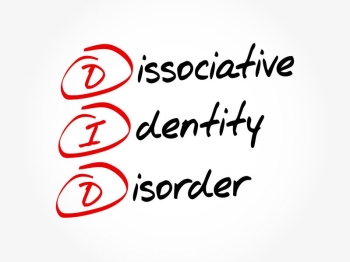
Dissociative Identity Disorder Treatment in Philadelphia: This advanced tip is designed for people with Dissociative Identity Disorder (DID) who already recognize all of their alters and the host. For people with DID, switching is described as the process of changing from one alter or personality to another. People with DID have varying levels of awareness about their switching. Often people will experience some kind of physical symptom, like headaches, just before or after switching occurs. Loosing track of time could be another indicator that a person switched. Obviously finding yourself in a place or situation in which you have no idea how you got there is a sign that you have switched. It is normal for switching to occur at inopportune times, which can be disruptive and problematic for the host. In addition, switching at inappropriate times can be frightening to the alters. Imagine your adult host self out on an enjoyable date, but then something happens (often something negative or at least an extreme feeling) and you switch to a six year old alter. Chances are your six year old alter will be even less prepared and really won’t have a good time on the outing – never mind your date who is suddenly out with a six year old – and may not even know it!
Increasing awareness of your switching can help you become more in control of your switching. Having more control over your switching can help your life run more smoothly and efficiently. This will help you more easily complete daily life tasks as well as your long-term goals. By being in more control of your switching, you will be better able to take care of yourself and your alters. For example, just as it is in your best interest to stay present for a date, it is also in the best interest of your six year old alter to not attend the date either. Becoming more aware of your switching requires you to track two separate things: first, your overall incidents of switching and second, each alter’s specific incidents of switching.
Overall Switching Table—A Basic Tracking Tool used in Dissociative Identity Disorder Treatment
The overall record of your switching can serve as a basic tracking mechanism of how frequently you are switching and who you are switching to. Unlike the tables that track each alter’s specific pattern to switching, this table does not have to provide extensive detail. This table provides a snapshot of basic information about your switching. This table should include the following information: time & date, “I was…”, and “I switched to…” See example below. Note some alters will be able to do a better job than others at recognizing when they switched and who emerged. This phenomenon is normal, with time each alter will get better and may even learn how to ask for help from the others more clearly.
Time & Date: January 7th 2012, around 10pm
I was…myself, the host
I switched to…Frank
Time & Date: January 7th 2012, around 11:30 pm
I was…Frank
I switched to…myself, the host
Time & Date: January 8th 2012, around 8am
I was…myself, the host
I switched to…Rachel
After tracking this information for a month, review your table. Each month record the total number of switches you experienced, who you switched to most often and who you switched to least often. Also tally the total number of switches for each alter. This will serve as an excellent way for you to keep track of basic switching patterns. After several months of this basic information, you can also organize the information into graphs to track the number of switches for each alter, and the overall number of switches. See example below of a monthly summary.
January 2012
Total switches: 36
Harry: 2
Frank: 16 *switched the most
Rachel: 8
Claire: 0 *switched the least
Lou: 3
Bobby: 6
Vinny: 1
Keep in mind that your table will not be 100% accurate. You and your alters may not know every time you switch, or every time a specific alter switches. This is normal and okay. The point is to begin to have some kind of way to track your possible baseline of switching.
Alter Switching Tables—Examining Patterns for Each Alter
Your second set of tables are designed to track each alter’s specific pattern to switching. Each alter serves a particular role or function to you, the host, and the system. If you are unsure of this role, complete a DID Role/Roll Call Sheet. The alter’s role likely influences when they switch. For instance, an alter whose role is to be a protector will likely switch and be present when you feel threatened. Personality traits could also influence when an alter switches. An alter who is highly organized may switch when you need to clean or pay your bills. Switching could also be related to simply the age of the alter. For instance, maybe one of your child alters switches at bath time because she loves to play in the water (this would even be more likely if you find bathing or showering difficult for some reason). These specific tables will help you better understand when and why an alter switches.
Once you know why you are switching to a specific alter, you will be able to be more in control of your switching. A long-term goal would be to have more incidents of planned switching or controlled switching, versus spontaneous switching. You will be able to have more incidents of planned switching once you understand what each alters triggers are. Furthermore knowing why each alter switches will provide you, the host, with information about what you need to work on so that your alter does not have to step in and do it for you. For instance, if one of your alters switches every time you must act assertively, it is likely that you need to learn how to act assertively. One great thing about having DID is that you can ask your alter who knows how to act assertively to teach you how to! Once you learn the various skills your alters do for you, they will likely not feel as though they have to switch for you.
Each alter should have a table and information pertaining to each alter’s switching will be kept in their individual table. At the top of the table include the alter’s name, sex, age range, role/function, strengths & weaknesses. For each switching incident involving that particular alter record the following information: time & date, “I was…”, “I switched to [alter’s name]…” environment, possible triggers, feedback from others, physical signs of switching. See example below.
Frank: male, 25-30 years old. Role/Function: The Manager. Strengths: assertive, confident, not afraid to speak his mind. Weaknesses: sometimes cocky and arrogant.
Time & Date: January 7th, 2012 around 10pm
I was…myself, host
And then I switched to FRANK
Environment: was out with my friends at a bar
Possible Triggers: friend john was bragging about his new promotion, I remember feeling jealous, especially since I don’t feel appreciated at work
Feedback from others: Friend Anne said I was acting rude to John
Physical signs of switching: Had headache all night, not completely sure what happened from 10-11:30pm, but I was also drinking
Time & Date: January 9th, 2012 around 2pm
I was …myself, host
And then I switched to FRANK
Environment: was at work, in meeting about new work teams
Possible Triggers: I dislike my coworker Andy and felt like he was showing off to our new team lead
Feedback from others: New team lead later told me I had some really good ideas at the meeting (which normally I would be too scared to share)
Physical signs of switching: headache, felt very tired
Time & Date: January 12th, 2012 around 11am
I was…myself, host
And then I switched to FRANK
Environment: at work, during meeting
Possible Triggers: felt very anxious about presenting my strategy in front of my new team and team lead, felt so anxious I considered quitting my job
Feedback from others: Team members told me that they really liked my proposal and new team lead said he “admired” my confidence!
Physical signs of switching: felt exhausted
After tracking the specific switching patterns for each alter for about a month, ask yourself the following questions about each alter:
What environment is [alter] most likely to switch in?
What conditions seem to be related to [atler’s] switching?
Knowing [alter’s] personality what might he/she be trying to help me with?
Remember, you’re not aiming for perfection in creating these tables. It is normal and okay for you not to be able to record ever incident of switching. As mentioned above, you and your alters may not be aware of every time someone switches. Simply try your best in trying to record the incidents of switching you are aware of. Your best, although not inclusive of all your switching experiences, will still provide you with valuable information!
Summary…Becoming more aware of your switching takes a lot of work and a significant amount of time. It is a long-term goal that will take multiple months, or even years to achieve. While trying to accomplish this task, give yourself permission to not have success! There will be points where you feel like you’re not making progress-this is normal and okay. Remind yourself that the process of becoming more aware of your switching can provide you with information that help you better manage your DID symptoms, help you and your alters work more effectively together, and allow you to have more control over your switching. Make sure to share the information you learn with people in your life who are aware of your diagnosis and may be able to help you. Remember, treatment is best done with the support of others.
Still struggling? Center for Growth / Dissociative Disorder Treatment in Philadelphia can help. Call today to speak with a counselor.

























